The following is not the typical read I share on this blog. It’s an explanation on how the author managed to efficiently turn the terminal into a web browser (Carbonyl). From a software engineering point-of-view, the author provides a clean explanation on how he implemented features and tweaks, by writing down interfaces and functions, which gives the impression that the browser is functional and divided by modules. From the graphical engineering point-of-view, the author provides a very detailed explanation on how things are implemented, which is jawbreaking.
Forking Chrome to render in a terminal
January 27, 2023
I wrote about forking Chrome to turn HTML to SVG two months ago, today we’re going to do something similar by making it render into a terminal.
Let me introduce you to the Carbonyl web browser!
Drawing
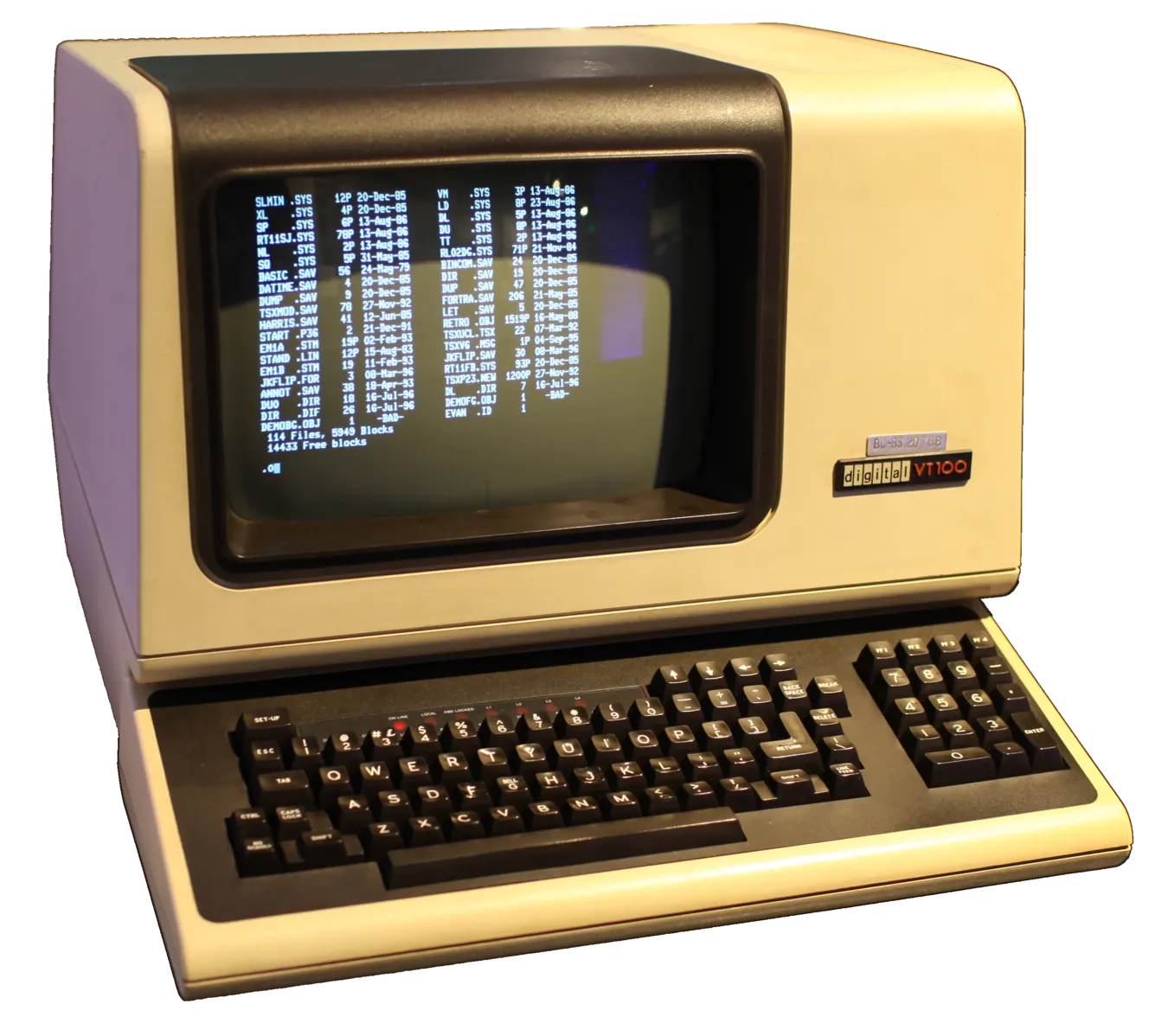
A DEC VT100 terminal (source)
There isn’t much you can draw in a terminal, you’re guaranteed to be able to render monospace characters in a fixed grid, and that’s it. Escape sequences exist to perform actions like moving the cursor, changing the text color, or mouse tracking. Some came from the days of physical terminals like the DEC VT100, others came from the xterm project.
Assuming a popular terminal emulator, we can:
- Move the cursor
- Write Unicode characters
- Set a character’s background and foreground color
- Use a 6x6x6 RGB palette, or 24 bits RGB if
COLORTERMis set thetruecolor
One of the unicode characters we can render is the lower half block element U+2584: ▄. Knowing that cells generally have an aspect ratio of 1:2, we can render perfectly square pixels by setting the background color to the top pixel color, and the foregound color to the bottom pixel color.
Let’s hook html2svg’s output into a Rust program:

fn move_cursor((x, y): (usize, usize)) {
println!("\x1b[{};{}H", y + 1, x + 1)
}
fn set_foreground((r, g, b): (u8, u8, u8)) {
println!("\x1b[38;2;{};{};{}m", r, g, b)
}
fn set_background((r, g, b): (u8, u8, u8)) {
println!("\x1b[48;2;{};{};{}m", r, g, b)
}
fn print_pixels_pair(
top: (u8, u8, u8),
bottom: (u8, u8, u8),
cursor: (usize, usize)
) {
move_cursor(cursor);
set_background(top);
set_foreground(bottom);
println!("▄");
}
Not bad. To render text, we need to create a new Skia device using C++, lets call it TextCaptureDevice. We’ll make it call a draw_text function written in Rust. Just like in html2svg, we need to convert glyph IDs into unicode characters.

class TextCaptureDevice: public SkClipStackDevice {
void onDrawGlyphRunList(SkCanvas*,
const sktext::GlyphRunList& glyphRunList,
const SkPaint&,
const SkPaint& paint) override {
// Get the text position
auto position = localToDevice().mapRect(glyphRunList.origin());
for (auto& glyphRun : glyphRunList) {
auto runSize = glyphRun.runSize();
SkAutoSTArray<64, SkUnichar> unichars(runSize);
// Convert glyph IDs to Unicode characters
SkFontPriv::GlyphsToUnichars(glyphRun.font(),
glyphRun.glyphsIDs().data(),
runSize,
unichars.get());
// Draw that text on the terminal
draw_text(unichars.data(), runSize, position, paint.getColor());
}
}
}
Better! But the text is scrambled at the center. Our TextCaptureDevice does not account for occlusion, drawing a rectangle does not clear the text behind it.

Let’s add some code to the drawRect and drawRRect methods to clear the text if we’re filling with a solid color:
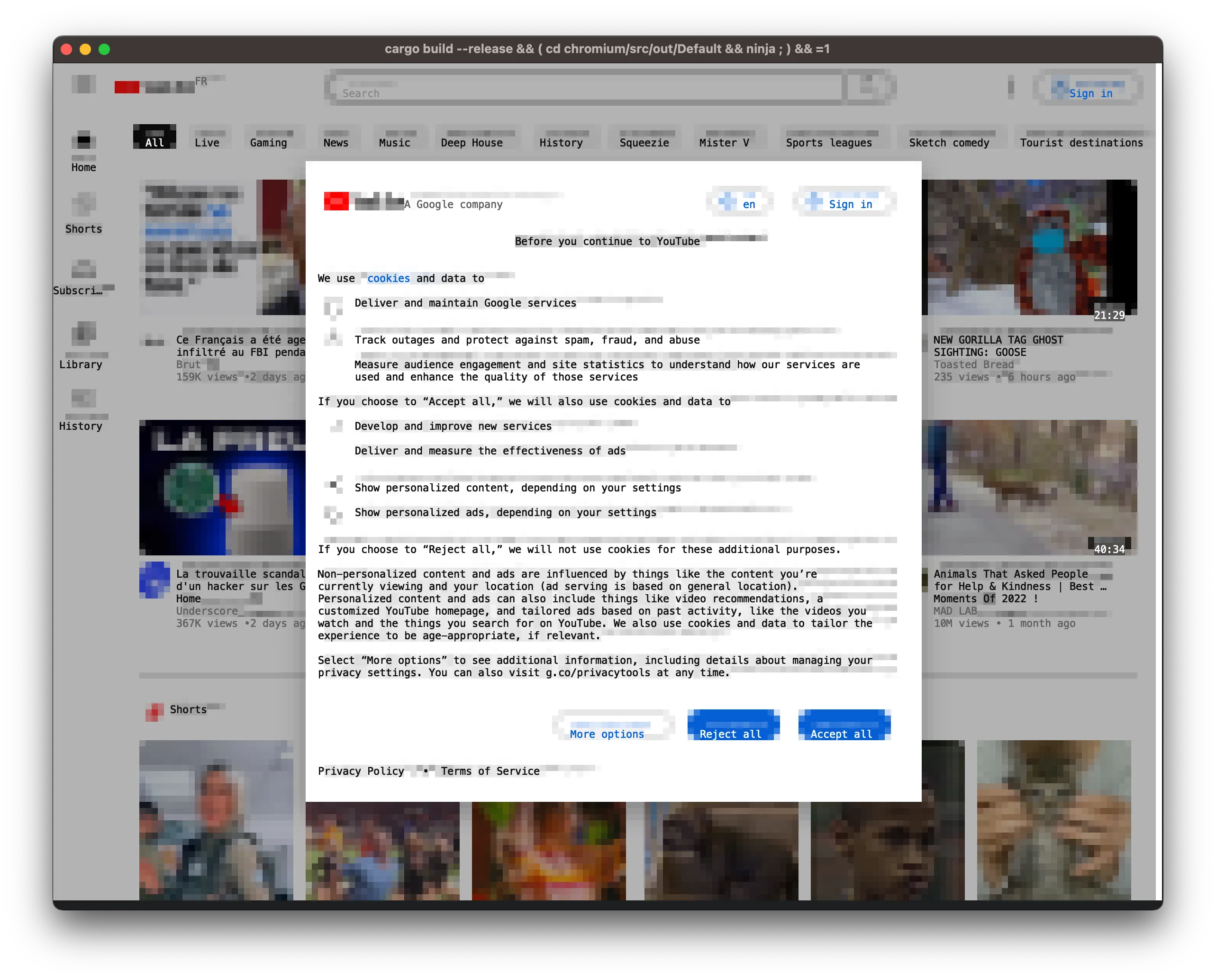
void drawRRect(const SkRRect& rect, const SkPaint& paint) override {
drawRect(rect.rect(), paint);
}
void drawRect(const SkRect& rect, const SkPaint& paint) override {
if (
paint.getStyle() == SkPaint::Style::kFill_Style &&
paint.getAlphaf() == 1.0
) {
clear_text(localToDevice().mapRect(rect));
}
}
The gray background behind text elements is caused by the software rasterizer rendering text in our bitmap. Let’s remove it:
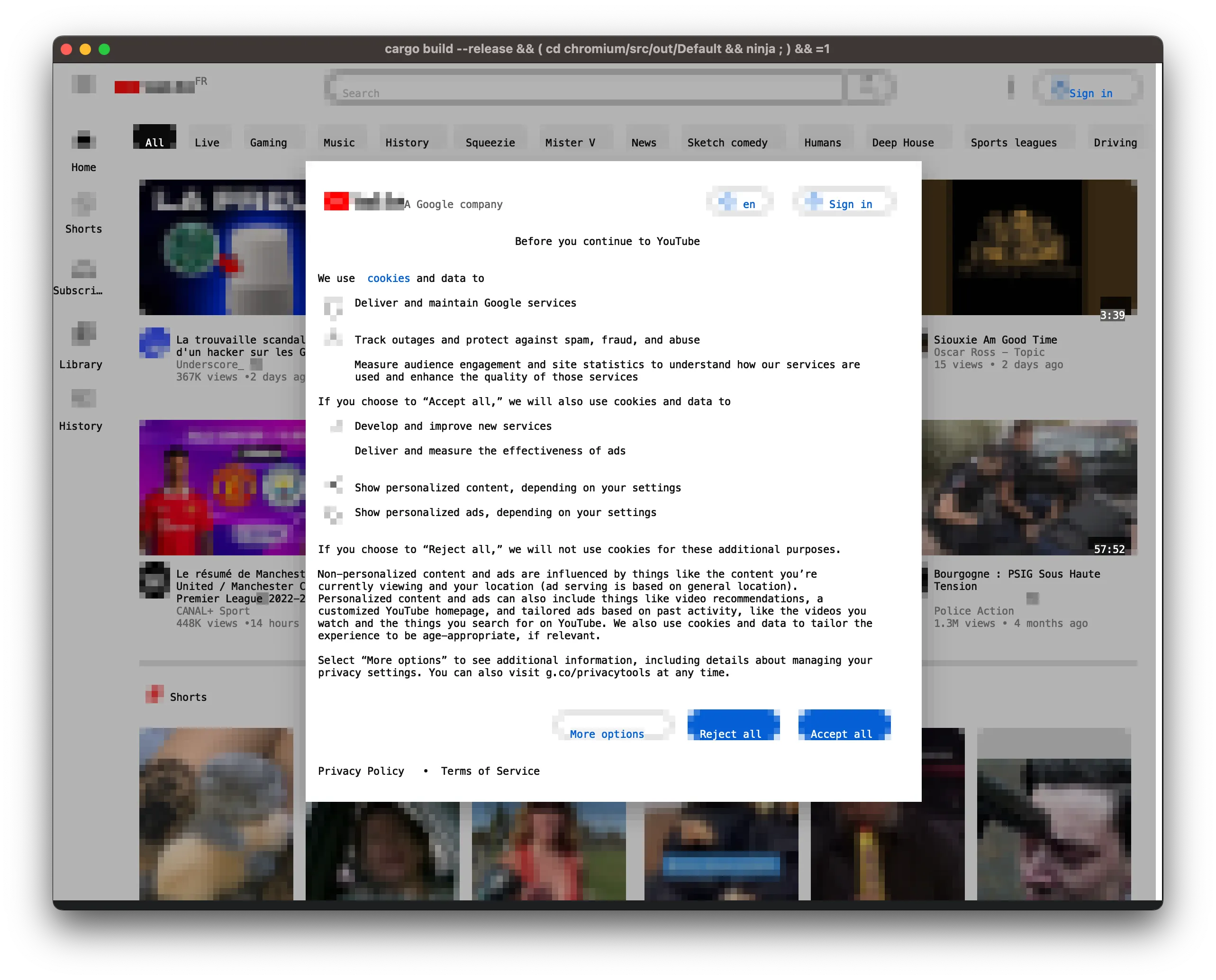
chromium/third_party/skia/src/core/SkBitmapDevice.cppline 521
void SkBitmapDevice::onDrawGlyphRunList(SkCanvas* canvas,
const sktext::GlyphRunList& glyphRunList,
const SkPaint& initialPaint,
const SkPaint& drawingPaint) {
- SkASSERT(!glyphRunList.hasRSXForm());
- LOOP_TILER( drawGlyphRunList(canvas, &fGlyphPainter, glyphRunList, drawingPaint), nullptr )
}
That was the easy part, let’s handle inputs!
Input
fn report_mouse_move((x, y): (usize, usize)) {
write!(get_stdin(), "\x1b[<35;{};{}M", y + 1, x + 1)
}
fn report_mouse_down((x, y): (usize, usize)) {
write!(get_stdin(), "\x1b[<0;{};{}M", y + 1, x + 1)
}
fn report_mouse_up((x, y): (usize, usize)) {
write!(get_stdin(), "\x1b[<0;{};{}m", y + 1, x + 1)
}
Some sequences exist to get a terminal emulator to track and report mouse events. For example, if you print \x1b[?1003h, the terminal should start sending events using this format:
These are similar to the sequences we use for styling our output. The \x1b[ prefix is called the Control Sequence Introducer.
carbonyl::browser->BrowserMainThread()->PostTask(
FROM_HERE,
base::BindOnce(
&HeadlessBrowserImpl::OnMouseDownInput,
x,
y
)
);
We need to notify the browser to wrap this up, but there is a catch: we need to block a thread to read stdin, but the browser methods should be called from the main thread. Thankfully, messages passing is available almost everywhere through the TaskRunner class.
Google recommending me Chrome, lol
carbonyl/src/input/parser.rsline 69
for &key in input {
sequence = match sequence {
Sequence::Char => match key {
0x1b => Sequence::Escape,
0x03 => emit!(Event::Exit),
key => emit!(Event::KeyPress { key }),
},
Sequence::Escape => match key {
b'[' => Sequence::Control,
b'P' => Sequence::DeviceControl(DeviceControl::new()),
0x1b =>
emit!(Event::KeyPress { key: 0x1b }; continue),
key => {
emit!(Event::KeyPress { key: 0x1b });
emit!(Event::KeyPress { key })
}
},
Sequence::Control => match key {
b'<' => Sequence::Mouse(Mouse::new()),
b'A' => emit!(Event::KeyPress { key: 0x26 }),
b'B' => emit!(Event::KeyPress { key: 0x28 }),
b'C' => emit!(Event::KeyPress { key: 0x27 }),
b'D' => emit!(Event::KeyPress { key: 0x25 }),
_ => Sequence::Char,
},
Sequence::Mouse(ref mut mouse) => parse!(mouse, key),
Sequence::DeviceControl(ref mut dcs) => parse!(dcs, key),
}
}
Pipe
We have something that sorts of work, at the cost of a steady 400% CPU usage, and that’s not counting iTerm2 which uses ~200%. We’ve got a few problems:
- We need too much resources to render at 5 FPS
- We render every time, even when nothing changes
- We print all characters even if they didn’t change on an individual level
Modern browsers employ a multi-process architecture to improve security. It separates websites into different processes, reducing the potential damage caused by vulnerabilities. The renderer process is running in an OS-level sandboxed environment that blocks certain system calls, such as file-system access. The GPU process, is also considered unprivileged and cannot reach renderer process in order to protect against vulnerabilities in GPU APIs such as WebGL. In contrast, the browser process, considered privileged, can communicate freely with any process.
Google ChromeBrowser ProcessGoogle Chrome Helper (Renderer)mouseMove(250, 250)mouseDown(250, 250)glBindBuffer()glDrawArray()👀Eyes🧠Brain🤌HandsRender ProcessmechanicalenergyelectromagneticenergyGitHubsuperintelligent ants risks - Google SearchGoogle Chrome Helper (Renderer)Render ProcessGoogle Chrome Helper (Renderer)Render Processdiy ant farm keyboard - YouTubeGoogle Chrome Helper (GPU)GPU Process
You need JavaScript to view this animation.
Renderer process(main)Browser processRenderer process(iframe)1. Get captureGPU process
doing this 60 times a second isn’t very efficient
CapturePaintPreview is great for html2svg, but it’s not designed for real-time rendering. It’s using IPC calls to correctly support out-of-process iframes, making roundtrips between the browser, GPU, and renderer processes. It downloads hardware accelerated images from the GPU, explaining the surprising memory bandwidth usage. We can disable the fetching, and even disable hardware acceleration, but we still have an expensive IPC machinery holding us back.
Software rendering is still very common, it even used to be the default if you can believe it. It was fairly easy back in the single-process days, but nowadays shared memory regions are configured to efficiently render using multiple processes. If we can get our pixels into one of these memory regions, we would just have to notify our browser process using a simple IPC message.
carbonyl/src/browser/host_display_client.ccline 28
void LayeredWindowUpdater::OnAllocatedSharedMemory(
const gfx::Size& pixel_size,
base::UnsafeSharedMemoryRegion region
) {
if (region.IsValid())
shm_mapping_ = region.Map();
}
void LayeredWindowUpdater::Draw(
const gfx::Rect& damage_rect,
DrawCallback draw_callback
) {
carbonyl_draw_bitmap(
shm_mapping_.GetMemoryAs<uint8_t>(),
shm_mapping_.size()
);
std::move(draw_callback).Run();
}
In order to setup this shared memory, we need to implement a HostDisplayClient and a SoftwareOutputDevice to manage a custom LayeredWindowUpdater which implements OnAllocatedSharedMemory().
HostDisplayClient runs in the browser process and is called by the GPU process through IPC. To wrap this up we need to make the GPU process use our custom display client by adding the following to VizProcessTransportFactory::OnEstablishedGpuChannel():
chromium/content/browser/compositor/viz_process_transport_factory.ccline 402
compositor_data.display_client =
- std::make_unique<HostDisplayClient>(compositor);
+ std::make_unique<carbonyl::HostDisplayClient>();
We solved the bitmap problem, now how can we extract text data? This data lives in the renderer process, but our windowing code lives in the browser process. We need to make the renderer interact with the browser process.
Mojo
carbonyl/src/browser/carbonyl.mojom
// Our C++ bindings will be in the carbonyl::mojom namespace
module carbonyl.mojom;
// Import existing bindings to common structures
import "ui/gfx/geometry/mojom/geometry.mojom";
import "skia/public/mojom/skcolor.mojom";
// Define a structure to hold text to render
struct TextData {
// An UTF-8 string with the contents
string contents;
// Bounds, size only defined for clearing
gfx.mojom.RectF bounds;
// Color of the text
skia.mojom.SkColor color;
};
// The browser process runs this service
interface CarbonylRenderService {
// The renderer process calls this method
DrawText(array<TextData> data);
};
Mojo is a library for inter-process communication. It defines an IDL for serializing data which supports native handles (i.e. file descriptors, shared memory regions, callbacks), and can be used to generate C++, Java (Android), and JavaScript (DevTools) bindings. It’s extensively documented, and fairly simple to use.
We’ll start by making an interface CarbonylRenderService that runs on the browser process, with a method DrawText called from the renderer process.
This .mojom code generates C++ temporary files which we can then include to write the implementation code.
Mojo receivers such as our service are part of the native handles we can send between processes, to register the implementation we just need to add it to the BrowserInterfaceBroker, which will get called by the renderer through BrowserInterfaceBrokerProxy:
chromium/content/browser/browser_interface_binders.ccline 890
map->Add<carbonyl::mojom::CarbonylRenderService>(
base::BindRepeating(&RenderFrameHostImpl::GetCarbonylRenderService,
base::Unretained(host)));
chromium/content/renderer/render_frame_impl.ccline 2206
GetBrowserInterfaceBroker().GetInterface(
std::move(carbonyl_render_service_receiver_)
);
Now, we need to get our text data without any expensive round-trip. Blink has a GetPaintRecord() method to get the latest paint data for a page, but it’s not behind a public API, which we need because our code runs in the content renderer. Ideally we should hook into the compositor (cc), but it’s way more involved. It’s dirty but we can workaround this by casting to the private blink::WebViewImpl:
auto* view = static_cast<blink::WebViewImpl*>(GetWebFrame()->View());
view->MainFrameImpl()->GetFrame()->View()->GetPaintRecord().Playback(&canvas);
carbonyl_render_service_->DrawText(std::move(data));
Surprise after the first run: the text content doesn’t follow the bitmap. Aaah, scrolling and animating is done on the compositor thread, which frees the main thread and makes everything smoother. Let’s procastinate doing things right by adding --disable-threaded-scrolling --disable-threaded-animation to the command line arguments.
Threaded compositing enabled
Threaded compositing disabled
Pretty smooth, it’ll be even smoother when threaded compositing is fixed! And we’ve fixed our biggest problem: we don’t use any CPU when idling, and scrolling consumes ~15%.
Layout
chromium/third_party/blink/renderer/core/css/resolver/style_resolver.ccline 954
auto font = state.StyleBuilder().GetFontDescription();
font.SetStretch(ExtraExpandedWidthValue());
font.SetKerning(FontDescription::kNoneKerning);
font.SetComputedSize(11.75 / 7.0);
font.SetGenericFamily(FontDescription::kMonospaceFamily);
font.SetIsAbsoluteSize(true);
state.StyleBuilder().SetFontDescription(font);
state.StyleBuilder().SetLineHeight(Length::Fixed(14.0 / 7.0));
Thing is, we can only render one font-size, but Blink doesn’t know that. This causes the layout to be messed up, with text chunks overlapping or overly spaced. This is especially visible on websites with a lot of textual content and links like Wikipedia.
Another dirty - yet effective - hack we can use is forcing a monospaced font on every element. We can do that by adding some code to StyleResolver::ResolveStyle.
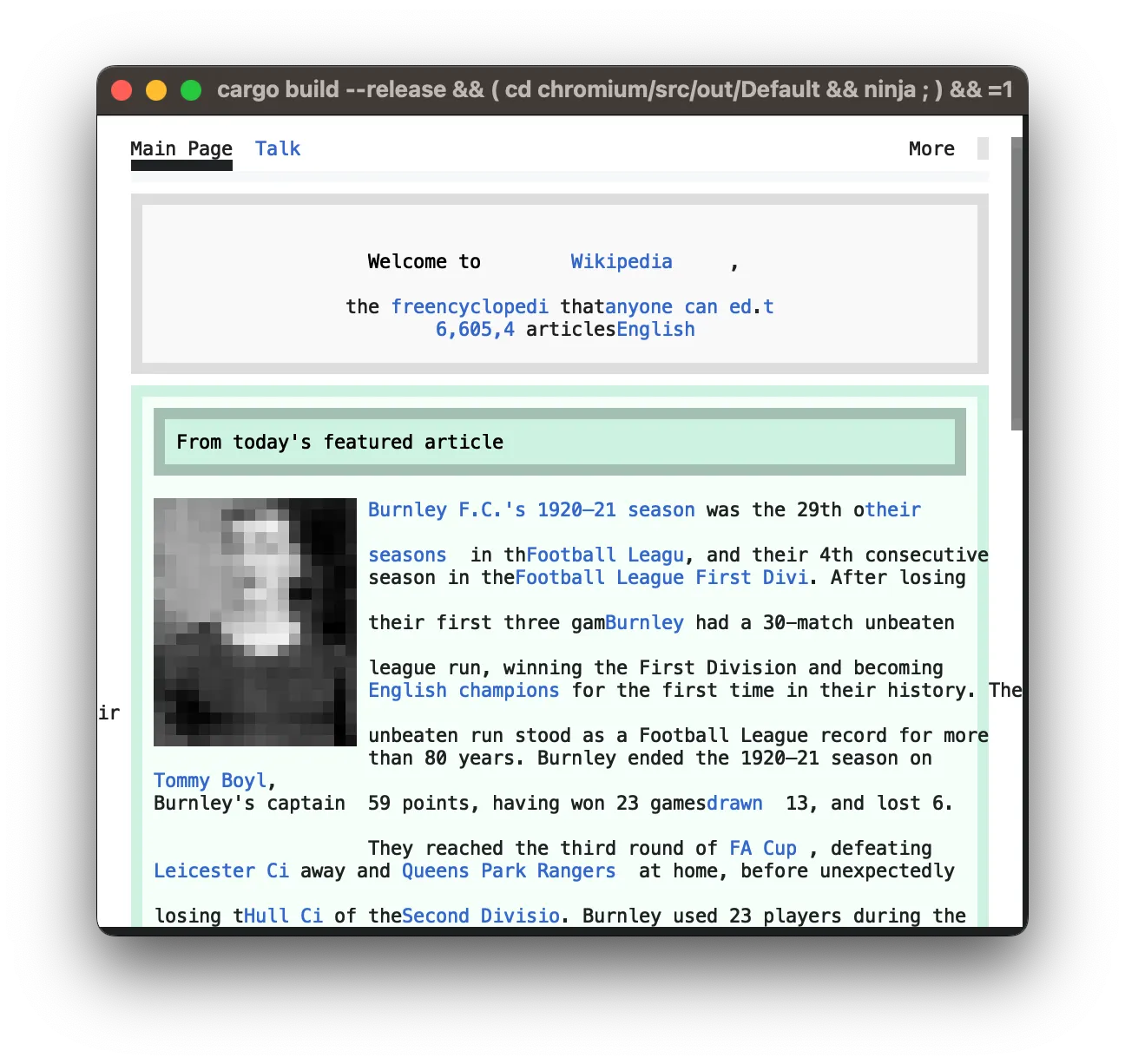
Default layout
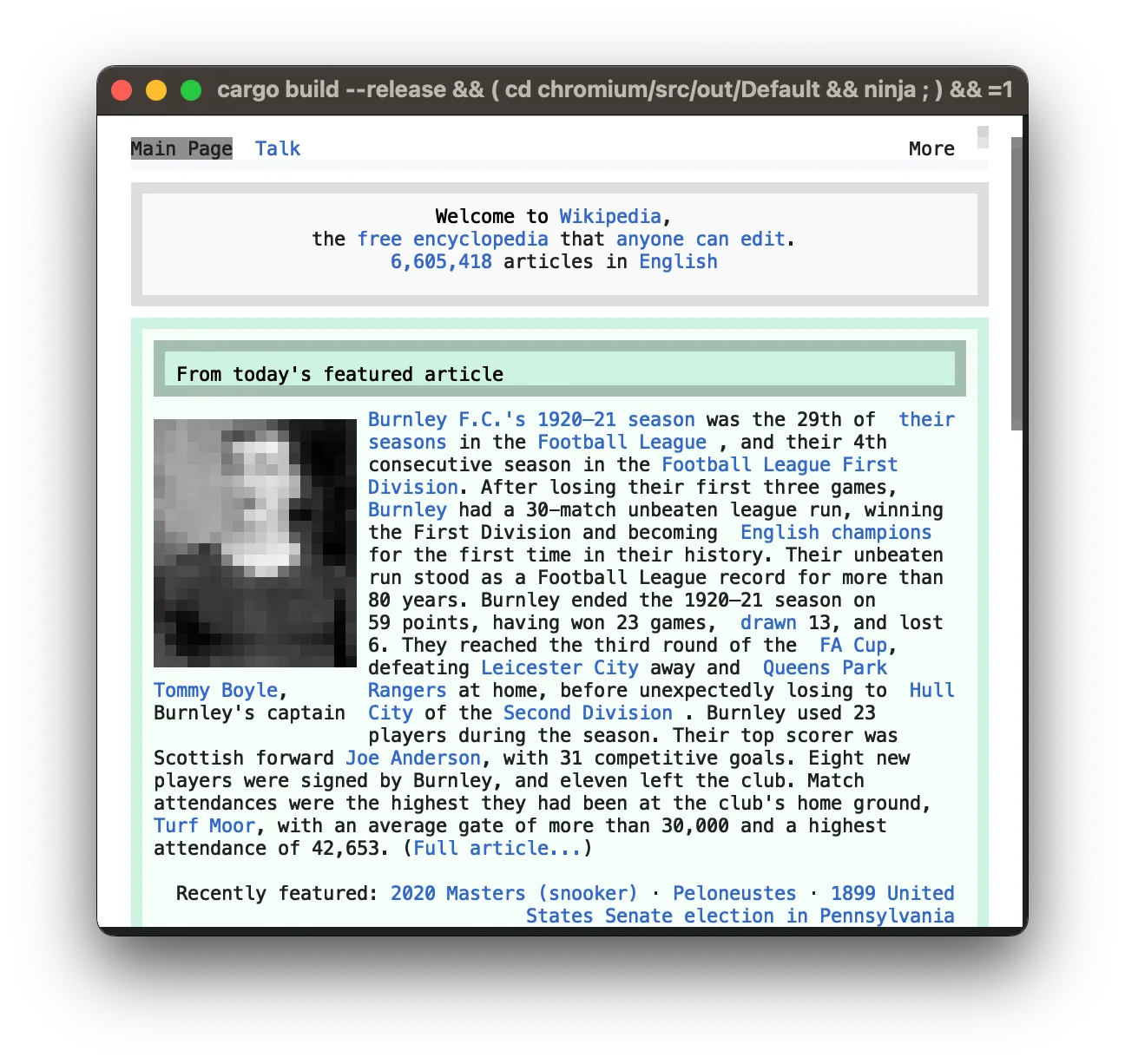
Fixed layout
LoDPI
chromium/ui/display/display.ccline 77
// static
float Display::GetForcedDeviceScaleFactor() {
return 1.0 / 7.0;
}
// static
bool Display::HasForceDeviceScaleFactor() {
return true;
}
One expensive step in our rendering pipeline is downscaling: we need to resize the framebuffer from its virtual space to its physical space. What we’re doing is kind of the opposite of HiDPI rendering, whose most common ratio is 2, which means 1 pixel on the web equals 4 pixels on the screen. Our ratio is 1 / 7 which means 49 pixels on the web renders to 1 block on our terminal.
The annoying thing about HiDPI is that it can make rendering ~4x slower, whereas Carbonyl LoDPI® makes rendering run ~49x faster. We just need to force our scaling into the Display class.
Color
I looked for examples of RGB color conversion to xterm-256 but the code I found was either wrong or slow because it did a nearest neighbor search. We’re going to do it for every pixel so it should run fast.
The formula for the conversion is fairly simple, assuming color values between 0 and 1: 16 + r * 5 * 36 + g * 5 * 6 + b * 5.
pub fn to_xterm(&self) -> u8 {
let r = (self.r as f32 - (95.0 - 40.0)).max(0.0) / 40.0;
let g = (self.g as f32 - (95.0 - 40.0)).max(0.0) / 40.0;
let b = (self.b as f32 - (95.0 - 40.0)).max(0.0) / 40.0;
(16.0 +
r.round() * 36.0 +
g.round() * 6.0 +
b.round()) as u8
}
The twist that most code online gets wrong is that the 6 color levels are not linear: 0, 95, 135, 175, 215, 255; there is a 95 gap between the first and second values, and 40 for the rest.
It makes sense to limit the dark range, color differences are more visible with bright colors. For us, it means that we can convert a value between 0 and 255 using max(0, color - 95 - 40) / 40.
carbonyl/src/output/xterm.rsline 4
pub fn to_xterm(&self) -> u8 {
if self.max_val() - self.min_val() < 8 {
match self.r {
0..=4 => 16,
5..=8 => 232,
238..=246 => 255,
247..=255 => 231,
r => 232 + (r - 8) / 10,
}
} else {
let scale = 5.0 / 200.0;
(16.0
+ self
.cast::<f32>()
.mul_add(scale, scale * -55.0)
.max(0.0)
.round()
.dot((36.0, 6.0, 1.0))) as u8
}
}
The conversion itself can be thought of as a dot product of (r, g, b) and (36, 6, 1). We can move the substraction to an mul_add call to help the compiler use a fused multiply-add instruction.
The last step is grayscale: our xterm profile offers 256 colors, there are the 216 colors from the RGB cube (6 * 6 * 6), the 16 configurable system colors, and 24 gray levels which go from rgb(8,8,8) to rgb(238,238,238).
To find out if a color is on a grayscale, we can substract its minimal value to its maximum value and check if it’s under a threshold, let’s say 8.
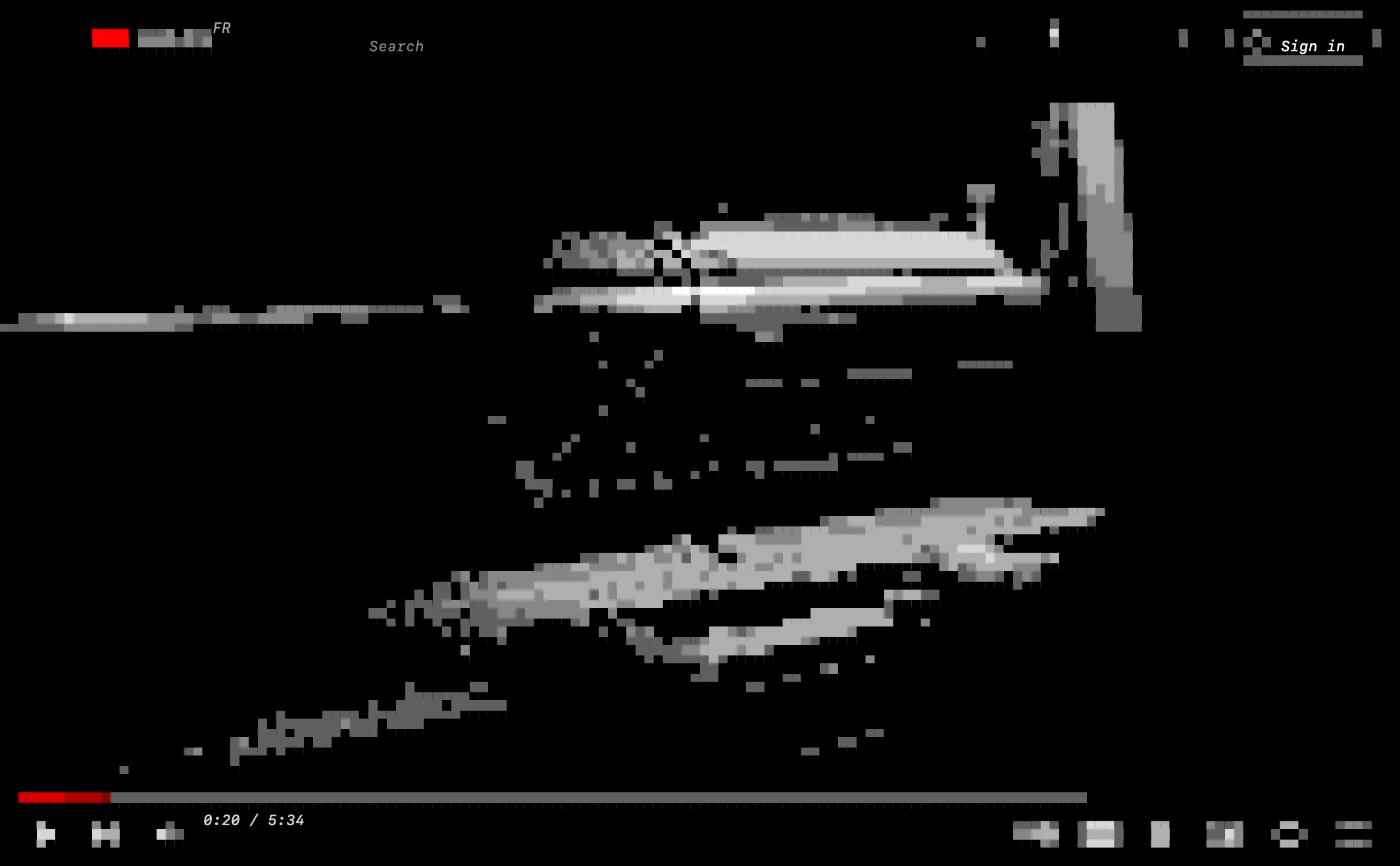
Simple RGB cube
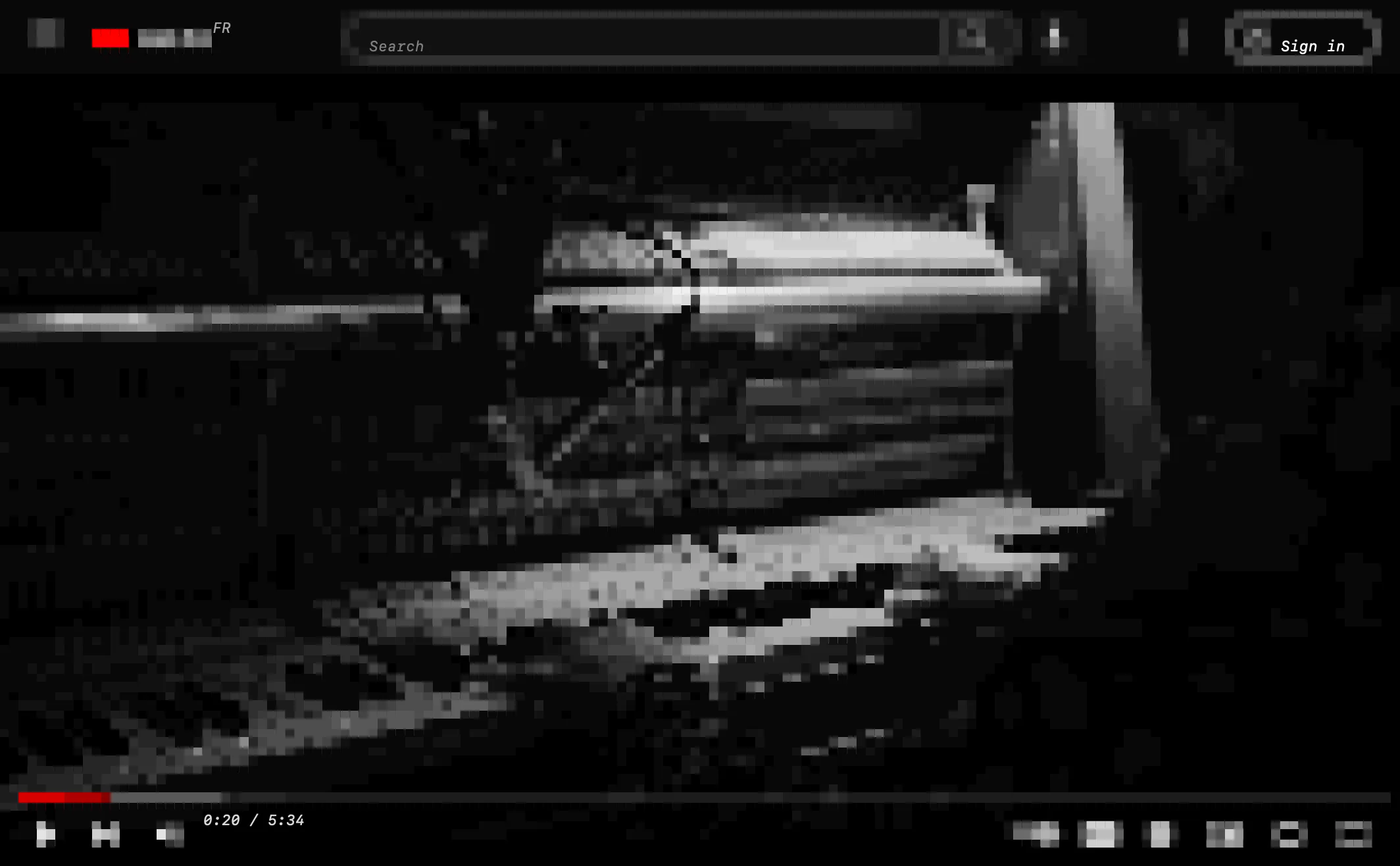
With grayscale code path
We still have one tiny problem: how can you detect if a terminal supports true-color or 256 colors? A quick Google search leads us to the COLORTERM environment variable, which is 24bit or truecolor if true-color is supported. But that won’t work in Docker or SSH, which are our primary targets.
carbonyl/src/input/dcs/parser.rsline 27
self.sequence = match self.sequence {
// ^[P1$r0;48:2:1:13:37:42m^[\
Code => match key {
b'0' | b'1' => Type(key),
_ => control_flow!(break)?,
},
// ^[P1$r0;48:2:1:13:37:42m^[\
Type(code) => match key {
b'$' => Status(StatusParser::new(code)),
b'+' => Resource(ResourceParser::new(code)),
_ => control_flow!(break)?,
},
// ^[P1$r0;48:2:1:13:37:42m^[\
Status(ref mut status) => return status.parse(key),
Resource(ref mut resource) => return resource.parse(key),
};
carbonyl/src/input/dcs/status.rsline 33
self.sequence = match self.sequence {
// ^[P1$r0;48:2:1:13:37:42m^[\
Start => match key {
b'r' => Value,
_ => control_flow!(break)?,
},
// ^[P1$r0;48:2:1:13:37:42m^[\
Value => match key {
// ^[P1$r0;48:2:1:13:37:42m^[\
0x1b => self.terminate(),
// ^[P1$r0;48:2:1:13:37:42m^[\
b';' => self.push_value(),
// ^[P1$r0;48:2:1:13:37:42m^[\
char => self.push_char(char),
},
// ^[P1$r0;48:2:1:13:37:42m^[\
Terminator => control_flow!(break self.parse_event(key))?,
};
A trick we can use is a DCS (Device Control Sequence) to fetch a setting value, like the current background color. If we set an RGB value and get an RGB value back, we can enable true-color.
You can try it by running the following on your terminal:
$ printf "\e[48;2;13;37;42m\eP\$qm\e\\"; cat
\e: start escape sequence[: introduce control sequence48: set foreground2: using an RGB color13: R is 1337: G is 3742: B is 42m: select graphic rendition
\e: start escape sequenceP: introduce device control sequence$: enter status modeq: query current settingm: select graphic rendition
If the commands are supported, you should get the following output with a dark turquoise background:
^[P1$r0;48:2:1:13:37:42m^[\
This is what the terminal emulator sends to stdin, and what we can parse to toggle true-color on.
Title
nice
A few xterm sequences allow setting the terminal window title, we could use that to display the current page title.
fn set_title(title: &str) {
// Set icon name and window title to string
println!("\x1b]0;{}\x07", title);
// Set icon name to string
println!("\x1b]1;{}\x07", title);
// Set window title to string
println!("\x1b]2;{}\x07", title);
}
To get notified when the title changes, we can simply implement WebContentsObserver::TitleWasSet():
void HeadlessWebContentsImpl::TitleWasSet(content::NavigationEntry* entry) {
carbonyl::Renderer::Main()->SetTitle(
base::UTF16ToUTF8(entry->GetTitleForDisplay())
);
}
Final thoughts
That’s all for today folks, check out Carbonyl on GitHub!
This was my first Rust project and I finally get the hype now. What a cool language!